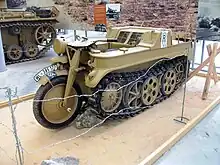Sd.Kfz. 2
The Sd.Kfz.2 (German: Sonderkraftfahrzeug 2) is a half-track motorcycle with a single front wheel, better known as the Kleines Kettenkraftrad HK 101 (from German klein 'small', Ketten 'chains/tracks', and kraftrad 'motorcycle'), shortened to Kettenkrad (pl. Kettenkräder). It was used by the military of Nazi Germany during the Second World War.

| Sd.Kfz.2 Kettenkrad HK 101 | |
|---|---|
 Kettenkrad in Russia, Winter 1943/44. | |
| Type | Light half-tracked gun tractor |
| Place of origin | Nazi Germany |
| Service history | |
| In service | 1941–1945 |
| Used by | Nazi Germany |
| Wars | World War II |
| Production history | |
| Designer | NSU |
| Designed | 1939 |
| Manufacturer | NSU Motorenwerke |
| Produced | 1939–1948 |
| Specifications | |
| Mass | 1,560 kg (3,440 lb) |
| Length | 3 m (9 ft 10 in) |
| Width | 1 m (3 ft 3 in) |
| Height | 1.2 m (3 ft 11 in) |
| Crew | 1 driver |
| Passengers | 2 passengers |
| Engine | Opel watercooled four-cylinder inline engine 36 bhp (26 kW) |
| Transmission | 3 forward/1 reverse × 2 range |
| Maximum speed | 70 km/h (44 mph) |
Design
The Kettenkrad started its life as a light tractor for airborne troops. The vehicle was designed to be delivered by Junkers Ju 52 aircraft, though not by parachute. The vehicle had the advantage of being the only gun tractor small enough to fit inside the hold of the Ju 52, and was the lightest mass-produced German military vehicle to use the complex Schachtellaufwerk overlapped and interleaved road wheels used on almost all German military half-tracked vehicles of World War II.
Steering the Kettenkrad was accomplished by turning the handlebars: Up to a certain point, only the front wheel would steer the vehicle. A motion of the handlebars beyond that point would engage the track brakes to help make turns sharper. It was also possible to run the vehicle without the front wheel installed and this was recommended in extreme off-road conditions where speed would be kept low.[1]
The Sd.Kfz.2 was designed and built by the NSU Werke AG at Neckarsulm, Germany. Patented in June 1939, it was first used in the invasion of the Soviet Union in 1941.[2] Later in the war Stoewer from Stettin also produced Kettenkrads under license, accounting for about 10% of the total production.[3]
The Kettenkrad came with a special trailer Sonderanhänger 1 (Sd.Anh.1) that could be attached to it to improve its cargo capacity. The trailer carried 350 kg (770 lb).
Being a tracked vehicle, the Kettenkrad could climb up to 24° in sand and even more on hard ground.[4]
Service

Most Kettenkräder saw service on the Eastern Front, where they were used to lay communication cables, pull heavy loads and carry soldiers through the deep Russian mud. Later in the war, Kettenkräder were used as runway tugs for aircraft, especially for the Messerschmitt Me 262 jet fighter, and sometimes the Arado Ar 234 jet reconnaissance-bomber. In order to save aviation fuel, German jet aircraft were towed to the runway, rather than taxiing under their own power.
The vehicle was also used in the North African theater and on the Western Front.
Variants
Only two significant sub-variations of the Kettenkrad were constructed. Production of the vehicle was stopped in 1944, at which time 8,345 had been built. After the war, production resumed at NSU. Around 550 Kettenkräder were built for agricultural use, with production ending in 1948 or 1949 (sources vary).
See also

- Springer (vehicle) (Sd.Kfz. 304), a one-use military demolition vehicle based on the Kettenkrad's powertrain.
- List of Sd.Kfz. designations
References
- Army manual D 624/1, Kleines Kettenkraftrad, Gerätebeschreibung und Bedienungsanweisung. OKH. 25 September 1944. p. 72.
- Ulzheimer, Philip (2006). "Kleines Kettenkraftrad (Sd.Kfz.2) Typ HK 101". kettenkrad.com. Retrieved 15 August 2014.
- Parada, George. "Vehicles of the Wehrmacht 1939–1945". Archived from the original on 20 October 2009. Retrieved 15 August 2014.
- Army manual D 624/1, Kleines Kettenkraftrad, Gerätebeschreibung und Bedienungsanweisung. OKH. 28 October 1942. p. 9.
External links
- Ulzheimer, Philip (2009). "Kettenkrad USA web site". kettenkrad.com.
- Mehlhorn, Andreas (2011–2023). "The NSU Kettenkrad Homepage". kettenkrad.de.
- "German Motorcycle Tractor". Tactical and Technical Trends. U.S. Military Intelligence Service (19). 25 February 1943.
- "Vues générales d'un Kettenkraftrad début de production avec ratelier pour équipements". military-kits.com (in French). 2014. Archived from the original on 2 October 2011. Retrieved 28 September 2007.
